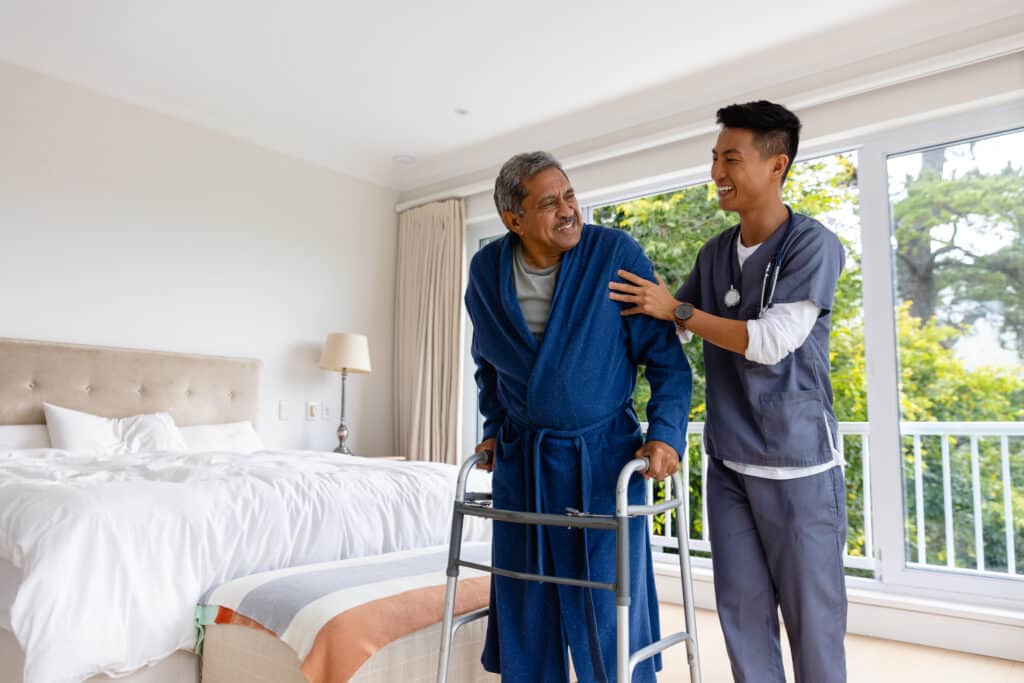Aging in place is a thoughtful decision that prioritizes living in a familiar and meaningful environment, which provides psychological benefits and a sense of independence.
Home comfort can significantly enhance the quality of life of adults with chronic health conditions. However, planning for this lifestyle involves careful consideration of safety and support needs.
This article explores the emotional aspects, practical steps, and professional guidance essential for aging-in-place remodeling. It offers a comprehensive guide to creating a safe and fulfilling home environment.
What Does It Mean to “Age in Place”?
Aging in place is more than just a fad; it’s a conscious choice to live your life in your own home in a way that’s meaningful to you. More importantly, change doesn’t have to mean completely rerooting yourself in a new environment.
Staying in your home offers more than just the familiarity of the physical space; it’s full of memories and experiences and can give you a sense of security and belonging where you live.
Preparing to stay in your home long-term may seem simple on the surface. However, several modifications and considerations are involved in making this major decision. For this reason, aging in place is often paired with the term remodeling, as significant changes are often needed to make the transition successful.
Having worked in multiple long-term living facilities for older adults, I’ve seen firsthand just how valuable the idea of living at home is for adults with chronic health conditions and their families. While it may not be practical for everyone, considering the benefits of aging in place can be beneficial for a number of reasons.
The Benefits of Aging in Place Remodeling
The psychological benefits of aging in place are promising; here are a few examples:
- Keeping your independence: Maintaining your daily routines and making decisions regarding your schedule can be empowering and let you live life in a way that feels good to you.
- Consistency: Those with memory issues or cognitive impairments experience less confusion when familiar with their environment.
- Support: Neighbors and community members can help you feel like you belong where you are, and the support around you can lend to a greater sense of security.
- Quality of life: Life satisfaction, self-esteem, and overall happiness are all associated with aging in place. Those who feel more stable, secure, and like they control their lives are happier.
There may be better choices than aging in place for some situations, and a senior living facility might be a better choice in these circumstances.
To decide which lifestyle is best for you, you must consider the level of care you need, what you can afford, and your personal preferences.
Beginning the Planning Process

Most older adults want to age in place, but when is the right time to start planning for home modifications? Like most things, planning and being prepared makes it less stressful when the time comes. In other words, the best time to plan is before it’s needed.
Even for the healthiest people, more difficulty with daily activities is a normal part of aging. This isn’t an issue in most cases because you can still do modified versions of most activities safely.
However, perhaps you’ve started to notice significant difficulty with everyday things. If going up and down the stairs or reaching things on high shelves has become difficult, and a regular exercise routine or physical therapy isn’t leaving you confident, it’s time to start thinking about remodeling to age in place.
Understanding the Emotional Impact of Aging in Place
Making the decision to age in place can be emotional. You’ll likely feel happy to keep control of your life and empowered by the ability to maintain your independence in the comfort of your own home.
On the other hand, changing your lifestyle to accommodate your changing body might be difficult to accept.
Loved ones often support the decision to age in place. Still, they may have some reservations due to safety concerns or the possible need for extra care. Sometimes, this can lead to a clash of opinions that needs to be sorted out for everyone’s peace of mind.
These are natural emotional responses to a big life decision, and it’s important to address everyone’s thoughts and feelings to ensure a smooth transition to your aging-in-place journey. When done thoughtfully, you’ll have a more robust support system.
Involving Loved Ones in the Process

Discussions of aging in place require open and honest communication. When everyone involved feels heard, it’s easier to devise a plan that honors your wishes while considering your family’s safety concerns.
You’ll want to discuss potential modifications to your home, what your daily life will look like, and what kind of support you may need. The right balance of your autonomy and your family’s peace of mind can make the decision to age in place one that everyone can get behind.
When your loved ones are included in the process from the beginning, they’re more prepared to help in the ways that you need. They’ll also feel better about their safety concerns if they can voice their thoughts during the planning and decision-making.
With a supportive network of friends and family, you’ll be able to navigate the process of preparing to age in place with people who care about your well-being. A united approach is a powerful way to ensure you have everything you need to live independently at home.
Professional Guidance from Occupational Therapists
As you prepare to age in place, you’ll want all the information you can get to ensure your plan addresses your needs.
Working with an occupational therapist (OT) can give you invaluable information on how to make your home safe and functional through modifications.
An OT can give you a personalized assessment and provide recommendations to adapt your living space to meet your needs and limitations. Getting expert advice from an occupational therapist allows you to better prepare your home and successfully remodel in a way that improves your quality of life.
Aging in Place Remodeling Best Practices
A safe and accessible home is the main reason those planning to age in place make home modifications.
If you can’t safely get around your house or aren’t able to do necessary daily tasks, your quality of life may start to decline.
Creating a space that allows you to move around without the fear of getting injured or feeling defeated by physical limitations that keep you from doing what you need is the best way to keep your independence and live a fulfilling life at home.
Adapting to Specific Needs & Health Conditions
Depending on your specific needs, various aging-in-place remodeling approaches can be used, from stair lifts and ramps to walk-in showers and raised toilets.
Your home modification will be unique to your needs and preferences, so picking the right home medical equipment for your condition will help you maintain independence. Here are a few examples of home medical equipment that is commonly used for aging-in-place remodels:
Mobility Aids

Those with mobility issues who plan to age in place benefit tremendously from equipment such as walkers, canes, scooters, and wheelchairs. Moving through your home without the proper support makes falls and injuries more likely.
Bathroom Aids (Elevated Toilet Seats and Grab Bars)
Shower chairs and transfer benches prevent falls, especially since showers and tubs can be slippery and unstable. Depending on your mobility, you can also consider roll-in showers and raised toilet seats to make it easier to sit and stand.
Adjustable Beds
Those who spend significant time in bed may need adjustable beds to remain comfortable. Adjusting the bed height can also help reduce the likelihood of falls when moving in and out of bed, and side rails can help with safety.
Stair Lifts, Ramps & Handrails
Difficulty navigating stairs means it’s time to make some changes. Adding a stair lift or ramp allows you to maintain access to your home with a much lower risk of injury.
Kitchen Modifications
Consider pull-down shelves or a pull-out pantry to reduce how far you need to reach, shallow sinks to avoid hunching over too much, rounded counter corners in case of falls, and grab rails if you need a little support while standing or walking.
Removing Throw Rugs
Reducing unnecessary throw rugs in your home is often a good idea when planning an aging-in-place strategy. While rugs might be pleasant as a decorative device, they also tend to be a prominent fall hazard.
Rugs that may slide on slick surfaces like tile or hardwood can present a sliding risk, while rugs on carpet or any other surface may tend to get bunched up, leading to a tripping hazard.
Pill Organization
Taking the guesswork out of which pills to take—and when to take them—can be a helpful addition. This is particularly true for older people who experience memory lapses.
Many options are available to help manage pill organization. If you are unsure where to begin, ask your doctor or pharmacist for guidance.
Food Delivery Services
Although mobility is important, food delivery services are a helpful addition to modern life for many seniors. Delivery services can now deliver anything from groceries to meals from your favorite restaurant right to your front door. A variety of meal delivery services are available in most metropolitan areas.
Home Health Aides

Many hospitals and independent providers offer home health aides as a common service. Depending on your needs, a home health aide may be able to assist you with nursing or medical care in the comfort of your home, and some may even be covered by your insurance. Talk to your doctor or insurance provider to explore home healthcare options to meet your needs.
Bedside Commode
Depending on your needs, a bedside commode may be a useful option. If you deal with chronic illness and are prone to difficulty making your way to the bathroom at night or at any other time, a bedside commode may be just the solution you’re looking for.
Considering your current physical limitations and the support you may need in the future is vital to making a comprehensive remodeling plan. Some equipment is larger and requires more work to install. Still, you don’t necessarily have to do a major home renovation to make your home safe and accessible.
By taking the time to consider what aging in place means to you, your current needs and how they may change, and how you want your daily life to look, you can create a space that continues to be comfortable and fosters independence for years to come.
Key Takeaways
- Aging in place means living in a meaningful, familiar environment that offers security.
- It is valuable for adults with chronic health conditions, providing psychological benefits and a sense of independence.
- Maintaining daily routines and personal schedules is empowering.
- Familiar environments reduce confusion for those with memory issues or cognitive impairments.
- Community and neighborly support enhance security and belonging.
- Higher life satisfaction, self-esteem, and overall happiness are associated with aging in place.
- Planning for aging in place should begin before it is needed to reduce stress.
- Difficulty with daily activities like navigating stairs or reaching high shelves indicates the need for home modifications.
- The decision to age in place can be emotionally challenging, balancing independence with safety concerns.
- Communication with loved ones is crucial for planning and addressing everyone’s concerns.
- Occupational therapists can provide valuable advice on home modifications to ensure safety and functionality.
- Home modifications, such as mobility aids, bathroom aids, and kitchen adaptations, are essential for maintaining independence.
- Removing throw rugs can reduce fall hazards.
- Pill organization tools and food delivery services can simplify daily routines.
- Home health aides can provide medical care and support at home.
- Considering current and future physical limitations is vital for a comprehensive remodeling plan.
References






